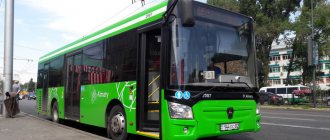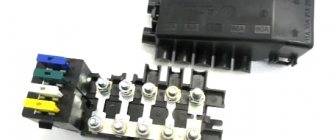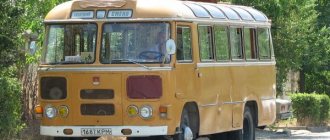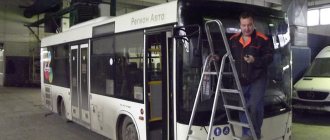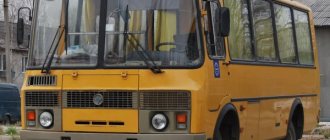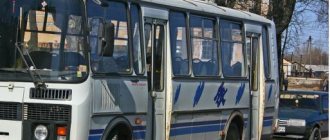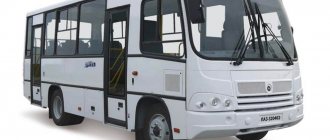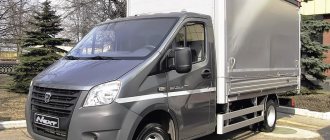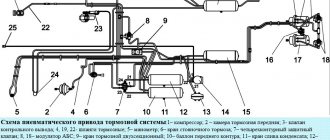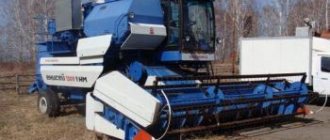–
Home
–
Bus catalog
–
MAZ
–
Bus MAZ-152
Manufacturers
Catalog and selection of bus according to parameters. Which dealer can you buy a bus from? Go to the catalog section and select the model, bus class, technical specifications, etc.
Euro-2 / Euro-3
| (0) |
Purpose of the bus: Intercity buses Bus class: Large (10.5-12.5m) Manufacturer: MAZ Where to buy (list of dealers): OJSC "MOSMAZSERVIS" Manufacturer news Company news: MAZ Engine type Diesel Fuel consumption (l./100 km.) 32 Buy Used: MAZ Buy new: MAZ
Buy Bus Catalog Comparison
Full description
The MAZ-152
intercity bus is designed to transport passengers over long distances, meeting European standards and the requirements of modern international transportation). At the request of the customer, the following are installed: air conditioning, mini kitchen, refrigerator, audio-video system, toilet, microwave oven.
General overview of the model
The bus is intended primarily for passenger transportation over long distances. Therefore, it is actively used for intercity routes.
A transport vehicle going on a long journey must have certain technical characteristics, and the MAZ-152 bus has such indicators. Thus, due to the use of separate components from cargo models, it received an increased level of endurance and strength. In addition, this technique allowed manufacturers to reduce the cost of their products.
Serial production of this brand of bus began in 2000. During this time, the vehicle came in two modifications:
- MAZ-152 itself;
- MAZ-152A, which has an expanded list of available options.
Only persons who have reached the age of majority, have a driver’s license of the required category, and have studied the rules for operating the bus are allowed to drive the latter. And to get acquainted with them and learn to drive, simulators are used. Educational games have also been developed separately for the MAZ-152 bus (OMSI is one of them).
MAZ-152. Specifications
Bus
Bus MAZ 152
Operating manual 152063-0000020 RE
Minsk 2013
The operating manual* contains information about the design, characteristics of the MAZ 152 bus, its components and instructions necessary for proper and safe operation, maintenance, routine repairs, storage and transportation.
The second and third sections contain information on the management and operating rules of the bus. This information is intended mainly for the driver, so it must be with the driver on the bus.
The fourth and fifth sections contain information on the design and maintenance of bus systems and components. The information is intended for service personnel. The contents of the sections should be in areas that carry out the relevant maintenance work.
The structure and procedure for servicing the components and systems of the bus (engine, gearbox, air train, air heater, automatic fire extinguishing system) are given in the operational documentation for these components and systems.
The manual was developed by the team of the chief designer of the bus.
Responsible for the release is Lipsky N.A.
Please send your comments and suggestions regarding the content of the Guide to: [email protected]
The right to press is reserved for OJSC MAZ. Reproduction, translation and reproduction, even selectively, without written permission
research activities of MAZ OJSC are prohibited.
*Hereinafter Guide
Introduction
This Operation Manual is intended for drivers and maintenance personnel of operating organizations. It contains a technical description and operating rules for the MAZ 152 bus.
MAZ 152 bus – class III according to the classification of UNECE Rules No. 36, category M3 according to GOST 31286.
Buses are manufactured in climatic modification U1 in accordance with GOST 15150 and are intended for use on public roads.
Maintenance of bus components manufactured by other companies should be carried out in accordance with the instructions for the operation of these components.
The following symbols and abbreviations are used in this Manual: ABS – anti-lock braking system;
PBS (ASR) – traction control system; AKB – rechargeable battery;
ACSS – automatic centralized lubrication system; BC – switching unit;
CU – control unit;
Power steering – power steering; CL – control lamp;
Instrumentation – control and measuring instruments; Gearbox – gearbox;
PZh – engine fluid heater; PGU – pneumatic hydraulic booster;
SCR – (Selective Catalytic Reduction) exhaust gas toxicity suppression system based on the principle of selective catalytic reduction. The manual was developed based on the state of bus production as of April 1, 2013.
Due to ongoing work to improve buses, changes may be made to the design that are not reflected in this publication.
The following safety instructions are used in this Operating Instructions:
Warning! Serves as safety instructions for non-observance
the practice of which is dangerous to the life and health of people.
Serves to indicate methods and techniques, non-compliance with which
Attention!
This may cause the product to malfunction (risk of damage to the product), or require increased care when handling the product or materials.
Safety requirements
When working on an inspection pit, as well as in the case of using lifting devices, the bus wheels must be securely locked. If necessary, safety supports should be used.
Before carrying out repair or installation work on electrical equipment, it is necessary to de-energize the electrical equipment as a whole.
Before carrying out any work in the engine compartment and the train compartment, in order to prevent the automatic fire extinguishing system from triggering, disconnect the battery from the on-board network by disconnecting the ground wire from the battery terminal.
Carrying out repairs on a bus with the engine running is not allowed, with the exception of control and adjustment work that requires turning on the engine (if the work is carried out in the engine compartment or the train, then before carrying out the work it is necessary to disconnect the power connector of the base unit of the automatic fire extinguishing system).
Since coolant and brake fluid are poisonous, proper handling must be strictly observed.
When carrying out electric welding work on a bus, disconnect the battery from the on-board network, connect the “+” and “-” wires to each other and disconnect the connectors of the electronic control units (engine control, gearbox, ABS, PZD). Connect the ground wire of the welding machine in the immediate vicinity of the welding site. It is forbidden to lay the welding machine cable parallel to the electrical wiring of the bus.
When carrying out welding and drilling work in places where plastic pipelines are laid, protect them from high temperatures (over 60 °C) and welding splashes. The presence of air under pressure in the pneumatic system is not allowed during its repair, as well as during work related to welding and drilling.
After repairing a heavily damaged bus, carry out all technical control measurements required for the bus before putting it into operation. It is prohibited to leave the driver’s workplace while the engine is running and not
parking brake applied.
FIRE SAFETY REQUIREMENTS
Strictly comply with the safety requirements given in the Operation Manual “Vehicle Automatic Fire Extinguishing System”.
Strictly comply with fire safety requirements for enterprises and organizations carrying out maintenance and repair of vehicles (in the territory of the Republic of Belarus - PPB 2.06-2000).
When repairing electrical equipment, the use of gasoline and other explosive solvents is strictly prohibited. When carrying out such work, non-flammable solvents should be used. Assembly must be performed after preliminary drying of the parts. Avoid getting various cleaning solutions into connecting panels, bundles of wires and windings of electrical equipment.
It is not allowed to accumulate dirt mixed with oil or fuel on the engine and the engine compartment casing, and it is not allowed to leave cleaning materials in the engine shaft.
It is prohibited to smoke and use open flames when working in the motor shaft and the engine compartment.
It is prohibited to operate the bus if there is leakage of fuel, oil or other operating fluids.
It is prohibited to operate the bus if the insulation of electrical equipment wires is damaged.
It is prohibited to heat the engine with an open flame.
The use of open flames in the passenger compartment and driver's compartment is prohibited. It is prohibited to store or transport flammable liquids and gases on the bus.
During operation and storage of the bus, it is prohibited to have any materials in the engine compartment and railway compartment that are not provided for by the design of the bus.
Driving with one or two paired tires flat is prohibited. It is prohibited to operate PZhD and air heaters in enclosed spaces.
due to the danger of poisoning and suffocation.
It is prohibited to operate air heaters and air heaters at gas stations and in places where flammable vapors and dust can form (for example, near fuel, coal, wood warehouses, etc.).
When the “FIRE” signal appears on the control panel of the automatic fire extinguishing system while driving, the driver must:
- immediately stop the bus, open all doors, press the emergency switch button, disembark passengers and remove them to a safe distance;
- act in strict accordance with the requirements of the Operation Manual “Vehicle Automatic Fire Extinguishing System”.
- the engine compartment hatch cover can be opened no earlier than 5 minutes after turning on the fire extinguishing system (the sign of activation is the release of white aerosol from the compartment) in order to prevent re-ignition due to a decrease in the concentration of the aerosol due to its leakage and dilution with fresh air;
- after extinguishing the source of fire, remove the remaining aerosol by ventilation, remove the settled aerosol by dry or wet wiping;
- Enter the bus only after the interior has been ventilated.
OPERATING LIMITATIONS
Allow drivers who have been trained in the rules of operating the MAZ 152 bus to operate a bus. Particular attention should be paid to studying the requirements of the Operation Manual “Automatic Fire Extinguishing System of a Vehicle.”
Before you start operating the bus, you must carefully study its structure, instructions for operation, maintenance and care set out in this Manual and the Operating Manuals for the bus components.
Normal operation of the bus units and mechanisms is ensured if fuel, oils and other operating materials are used in accordance with the instructions given in the “Chemmotological Card” of this Manual. It is necessary to comply with the scope and frequency of maintenance specified in this Manual, with the frequency adjusted depending on road and climatic operating conditions in accordance with GOST 21624-81 with a record of the work performed in the service book.
During the break-in period of the bus, strictly follow the instructions given in this Manual (section “Running in the bus”), since its further performance largely depends on how well the parts work in during the initial period of operation.
While driving, monitor the readings of instrumentation and warning lights.
Do not start moving the bus when the air pressure in the pneumatic drive circuits of the brake mechanisms is below 550 kPa (5.5 kgf/cm2), i.e. until the warning lights indicating a drop in air pressure go out.
It is prohibited to coast the bus when the engine is not running, since in this case the force on the steering wheel increases sharply and the supply of compressed air in the bus pneumatic system is not replenished.
Do not start the engine without oil and coolant. Do not fill oil above the top mark on the dipstick.
Do not open the steam valve cap on the expansion tank. It is prohibited to start the engine from an external power source connected
connection of wires to the starter terminals.
Do not use a charging station or jump starter to start the engine.
It is forbidden to start driving while the buzzer is sounding.
It is prohibited to operate a bus with a faulty or failed power steering.
It is prohibited to drive downhill with the gear switched off.
On descents, it is necessary to prevent the bus from moving at engine speeds higher than permissible, i.e. The tachometer needle should not enter the red zone of the instrument scale.
Do not operate the fuel pedal when the engine brake is on.
Do not stop the engine when the coolant temperature is above 95 °C.
It is prohibited to disconnect the wires from the terminals of the generator and batteries while the engine is running.
To avoid damage to the gearbox drive and clutch drive, it is prohibited to leave the gear engaged after stopping the engine, and also to disengage the clutch when there is no air in the air consumer circuit.
When washing a bus, it is prohibited to direct a stream of water at the air intake grille, as well as at electrical equipment and electrical wire connection points.
In winter, when washing a bus, it is prohibited to direct a stream of water at the brakes. If condensate freezes in the brake pneumatic drive, it is prohibited to warm up the devices, pipelines and air receivers with an open flame. If there is a danger of water freezing in the kitchen or water system tank,
Kitchen supplies should be completely removed from the kitchen and tank.
The bus is equipped with a system that prevents it from starting when the doors are open. For the safety of passenger transportation, we strongly recommend that you do not operate buses with a disabled or faulty automatic parking brake system when the passenger compartment doors are open.
MAZ-152.
General description of Buses, Technical characteristics
1.1 MAZ-152.
BUS INFORMATION DATA
The bus identification number is stamped on the right front pillar (behind the rotating panel, near the headlight), as well as on the nameplate, which is located on the front panel (to the right of the front door entrance).
The structure of the identification number (VIN) is as follows: Y3М152063D0002505 (17 characters), where:
Y – geographical zone of the Republic of Belarus; 3 – international code of the Republic of Belarus;
M – international code of the Minsk Automobile Plant;
152063 (6 characters) – designation of the bus model (modification), where: 1 (4th character) – serial number of the bus generation (1st generation);
5 (5th) – bus destination code (5 – intercity, tourist buses); 2 (6th digit) – serial number of the model;
0 (7th character) – body modification code (0 – without toilet, A – with toilet); 6 (8th character) – engine manufacturer (6 – Daimler);
3 (9th character) – power unit configuration code;
D (10th character) – year of manufacture of the bus (D 2013; E 2014, etc.);
0002505 (7 characters) – serial production number of the vehicle.
Along with the identification number, the nameplate also contains:
- logo of the Minsk Automobile Plant;
- “Type Approval” number of the vehicle;
- total weight of the bus, kg;
- permissible axle load on each axle, kg;
- type of installed engine.
The model and production number of the bus, the model and number of the engine, as well as the numbers of components and assemblies are given in the “Service Book”, which is attached to each bus.
MAZ-152. WITH
leaving Buses
As of January 1, 2013, the plant produces MAZ 152 buses in the configuration shown in Table 1.1. The technical characteristics of the bus are given in Table 1.2, the technical characteristics of the engine are given in Table 1.3. At the customer's request, an automatic centralized
bathroom lubrication system (ACSS) of friction units.
Table 1.1 – Bus equipment
| Equipment designation | Engine | Transmission | Drive axle, i | Maximum speed*, km/h |
| 152063/A63 | OM 926 LA (Euro 5) | ZF 6S 1701 BO | 3,86 | 131 |
*Maximum speed may be limited depending on the destination of the bus
Table 1.2 Technical characteristics of buses MAZ 152, MAZ 152A
| Options | MAZ 152 | MAZ 152A |
| Number of seats | 43/45/47 | 43/45 |
| Luggage compartment volume, m3 | 7 | 6 |
| Luggage compartment floor area, m2 | 8,9 | 7,7 |
| Total area intended for passengers, m2 | 27,5 | |
| Number of service doors | 2 | |
| Internal cabin height in the aisle, mm | 2057 | |
| Height of the first step above the road level, mm, no more | 380 | |
| Floor height above road level, mm | 1165 | |
| Ground clearance of the front overhang, mm | 302 | |
| Rear overhang ground clearance, mm | 265 | |
| Rear suspension ground clearance, mm | 238 | |
| Height of front towing device, mm | 405 | |
| Rear towing device height, mm | 590 | |
| Empty weight, kg, no more | 13850/13910 | 14060 |
| Distribution of empty weight along axles, kg: front axle | 4685/ 4715 | 4790 |
| rear axle | 9165/ 9195 | 9270 |
| Gross weight (empty weight plus weight of passengers and luggage), kg | 18000 | |
| Distribution of total weight along axles, kg: front axle | 6500 | |
| rear axle | 11500 | |
| Technically permissible maximum weight, kg | 19000 | |
| Distribution of technically permissible maximum weight along the axles, kg: front axle | 6700 | |
| rear axle | 12300 | |
| The width of the corridor occupied by a bus when turning with an overall outer radius of 12.5 m, no more | 6,7 | |
| External minimum overall turning radius, m, no more | 12 | |
| Maximum incline overcome by a bus with full weight, %, not less | 30 | |
| Acceleration time of a bus with a rated load from standstill to a speed of 60 km/h, sec, no more | 50 | |
| The main dimensions of buses are shown in the figures | Fig.1.1a | Fig.1.1b |
Operating fuel consumption standards are not given in the Manual, since they are departmental documents for motor vehicles (in the Republic of Belarus, fuel consumption standards are developed and approved by the Ministry of Transport and Communications of the Republic of Belarus, in the Russian Federation - by the Ministry of Transport of the Russian Federation).
Table 1.3 – Engine technical characteristics
| Engine model | OM 926 LA V/1 |
| Type | Diesel, with turbocharging and charge air cooling |
| Environmental friendliness | Euro-5 (with SCR system) |
| Number of cylinders | 6 |
| Cylinder arrangement | in-line |
| Cylinder diameter, mm | 106 |
| Piston stroke, S, mm | 136 |
| Working volume, l | 7,2 |
| Rated power, kW (hp) | 240 (326) |
| Frequency at rated power, min-1 | 2200 |
| Maximum torque, Nm | 1300 |
| Frequency at max. torque, min-1 | 1200-1600 |
A)
b)
Figure 1.1 – Main dimensions and layout of the bus interior
a) MAZ 152 b) MAZ 152A
External overview of transport
The MAZ-152 bus is made of high-strength metal. Special agents have been added to its composition to protect it from corrosion. Some individual elements are made from alternative materials. Thus, the side parts are made of galvanized sheets, and fiberglass is used for the front.
It should also be said that the glass is not just inserted here, it is glued in. And this increases the overall rigidity of the body.
Access to the cabin is provided by two sliding doors. They open and close using an electro-pneumatic drive. Moreover, when the doors are open, the engine will not start - a special protection system is installed for this.
Bus interior
The bus interior is equipped to create comfortable travel conditions. Depending on the modification, the MAZ-152 bus can accommodate from forty-three to forty-seven seats. All of them have special adjustments:
- back position (this option allows you to change the angle of the backrest within fifteen degrees);
- shifting the seat as a whole to the side, allowing even plus-size people to sit comfortably in the chair;
- footrest position.
In addition to all this, the seats have an armrest on the side of the central aisle. Its position is also adjustable using a simple mechanism. Each passenger has an individual lighting source. The available options provide comfortable and pleasant conditions for traveling on the MAZ-152 bus.
To ensure safety, each seat is equipped with seat belts.
The floor of the bus is uneven. It gradually rises from the central door to the tail section. This is due to the location of the power unit.
Everything for the people
What's the first thing you look at when the bus pulls up to the platform? Yeah, of course, based on appearance and brand. Take your time - first you look at the route indicator, and then at everything else. “Mazovtsy” distinguished themselves here too. The side display on “231st” is original, built into the window opening.
Traditionally, two leaning-sliding doors lead into the salon. Moreover, like foreign analogues, a double-leaf 2nd door is provided. This was done not for the sake of increasing the speed of boarding and disembarking, but to be able to accommodate equipment for transporting persons with disabilities. In fact, it is enough now to equip a bus with buttons for communicating with the driver from several passenger seats, and it will receive approval for additional requirements.
In the meantime, there are 51 comfortable seats in the cabin and... no hint of the ability to transport the declared 20 standing passengers. Neither under the ceiling, nor on the shelves, nor even on the chairs is there any hint of handrails. Strange, although logical. It’s not worth driving the intercity while standing – the speeds are not the same and there are no seat belts for those who are standing.
But those who sit have personal ventilation and lighting units. On the outside, at the top, the body has efficient air intake and exhaust casings of complex internal shape. They distribute air not only to individual units, but also to the side windows. The original shape of the rear ceiling panel of the cabin made it possible, given the low height of the bus, to place individual blocks even above the last row of seats. It’s a pity that the “especially gifted” workers, who arbitrarily increased the mounting height of the last row of seats, significantly spoiled the overall impression of this undoubtedly useful idea. Finally, blower fans are built into the depths of the shelves with individual ventilation units. Therefore, unlike most intercity and suburban buses, even during 15–20-minute stops, the cabin will not become stuffy, as usually happens on almost any flight in the summer.
And for our winters, a progressive system of active convectors is installed in the cabin, when the heat pipes running at the feet of passengers give off heat more efficiently, since they have blocks with built-in fans that blow air through them.
And in general, the trip left a pleasant impression in any part of the cabin. It’s not noisy, nothing rattles, and most importantly, the ride is very smooth even when the car is empty. I was pleasantly surprised.
From the driver's point of view, the bus did not disappoint either, but there was less excitement here. Given my height, the top edge of the glass cuts off part of the right lens. The gearbox lever is too high, pushed close to the panel, forcing you to squeeze into the workplace. I would like to lower the glazing of the first door lower; after all, the transportation for which the bus is designed requires increased attention to this area.
On the positive side, I would like to note the heated side windows, a convenient left window, and a developed air duct system in the panel, which allows you to maintain an individual microclimate regardless of the frequency of stops along the route. I liked the large windshield and the “enveloping” panel. Another good feature is placing the speakers in the driver's shin area. The sound is quite spacious and clear and does not irritate passengers, which is often important.
I won’t write about THAT and ETO. Look at the photo and you yourself will understand what’s what. If only everyone did this...
Technical characteristics of the MAZ-231062 bus
| Total weight, kg | 18000 |
| Curb weight, kg | 11800 |
| Total passenger capacity/seated, persons | 80/ 51 |
| Permissible load on the 1st/2nd axle, kg | 6810/ 11190 |
Engine:
| OM 926LA.EEV/3, turbodiesel, I-6, Euro 5 7201 326 at 2200 min-1 1300 at 1200–1600 min-1 |
Transmission:
| ZF 6HP-1701 Mechanical 6/1 |
| Suspension | Dependent, with air springs and shock absorbers |
| Brake system | Pneumatic with ABS, ASR, ESP Disc brakes |
| Wheel formula | 4x2 |
| Fuel tank capacity, l | 280 |
Vehicle equipment
The MAZ-152 bus is equipped with various additional options and systems that create optimally comfortable travel conditions. So, on a hot day you will need an air conditioning and ventilation system, and in the cold season - a heating system.
There is also no need to stop along the way too often, since the bus is equipped with a dry toilet. Products can be placed in the refrigerator. There is even a small kitchen area where you can have a snack.
A long bus ride will not be boring. For this purpose there are audio and video systems. And in addition to all of the above, the bus is equipped with other functions:
- anti-lock braking system;
- traction control system;
- the ceiling is covered with a layer of thermal and noise insulation;
- a special “Avtolin” fabric is laid on the floor;
- the driver's seat is adjustable - it changes position due to the air spring;
- Window curtains will protect you from bright light.
